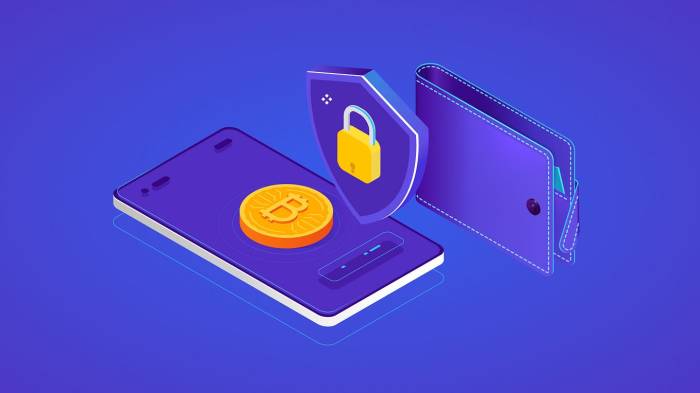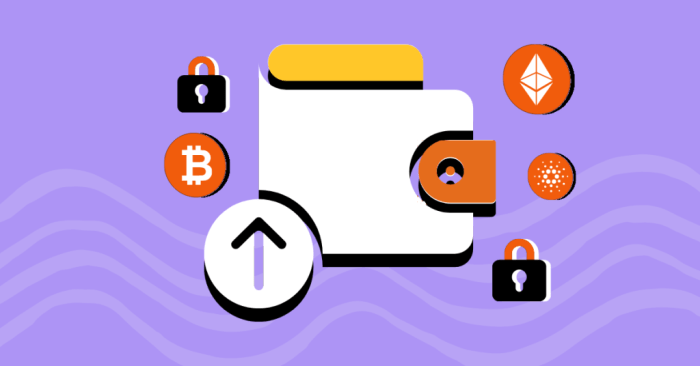How to Protect Your Crypto Assets is a crucial topic in today’s digital landscape. The decentralized nature of cryptocurrencies, while offering exciting possibilities, also presents unique security challenges. Understanding and implementing robust security measures is paramount to safeguarding your digital assets from theft, loss, or unauthorized access. This guide will explore various strategies and best practices to help you navigate the complexities of crypto security and protect your investments.
From selecting the right wallet and establishing strong passwords to understanding phishing techniques and diversifying your portfolio, we’ll cover a comprehensive range of topics. We will delve into the intricacies of private keys, seed phrases, and the importance of regular security audits. By the end of this guide, you will have a clearer understanding of the steps necessary to secure your crypto holdings and mitigate potential risks.
Choosing a Secure Wallet
Protecting your cryptocurrency requires selecting a secure wallet. The right choice depends on your technical skills, the amount of cryptocurrency you hold, and your comfort level with different security measures. Understanding the various types of wallets and their associated risks is crucial for safeguarding your digital assets.
Crypto Wallet Types
Cryptocurrency wallets are categorized into three main types: hardware, software, and paper. Each offers a different balance of security, convenience, and accessibility.
Hardware Wallets
Hardware wallets are physical devices resembling USB drives that store your private keys offline. This offline storage significantly reduces the risk of hacking, as your keys are never exposed to the internet. They typically feature a small screen to display transactions and require physical button presses to confirm actions. Examples include Ledger and Trezor.
Software Wallets
Software wallets are applications installed on your computer or mobile device. They offer greater convenience than hardware wallets, allowing for easier access to your funds. However, they are more vulnerable to malware and hacking if your device is compromised. Software wallets can be further categorized into desktop wallets (like Exodus or Electrum), mobile wallets (like Trust Wallet or Coinbase Wallet), and web wallets (like those offered by exchanges).
Paper Wallets
Paper wallets represent the simplest and most secure offline storage method. Your public and private keys are printed on a piece of paper. While highly secure against online threats, paper wallets are susceptible to physical damage, loss, or theft. They are best suited for long-term storage of smaller amounts of cryptocurrency.
Wallet Type Comparison
| Wallet Type | Security Features | Ease of Use | Strengths | Weaknesses |
|---|---|---|---|---|
| Hardware | Offline storage, PIN protection, multiple signature requirements | Moderate | Highest security, protects against most online threats | Can be expensive, requires physical access |
| Software | Password protection, two-factor authentication (2FA), encryption | High | Convenient, easy access to funds | Vulnerable to malware and hacking if device is compromised |
| Paper | Offline storage | Low | Highly secure against online threats | Susceptible to physical damage, loss, or theft; difficult to use for frequent transactions |
Setting Up a Secure Hardware Wallet
Setting up a hardware wallet involves several crucial steps to ensure its security. This process varies slightly depending on the specific hardware wallet model, but the general principles remain consistent.
- Purchase a reputable hardware wallet: Choose a well-established brand with a proven track record of security, such as Ledger or Trezor. Avoid purchasing from unofficial sources.
- Unpack the wallet carefully: Verify the device’s authenticity by checking for tamper-evident seals and comparing the device’s serial number to the one listed on the packaging.
- Connect the wallet to your computer: Use a fresh, unused computer or a virtual machine to minimize the risk of malware compromising your device.
- Follow the on-screen instructions: The wallet’s setup process will guide you through creating a seed phrase (a list of recovery words). This seed phrase is critically important. Write it down carefully on the provided recovery sheet, and store it securely in a separate, offline location.
- Create a strong PIN: Choose a complex PIN that is difficult to guess.
- Verify your seed phrase: The wallet will likely ask you to re-enter some of the words from your seed phrase to ensure you’ve recorded them correctly.
- Install the wallet software: Download and install the official wallet software for your chosen operating system from the manufacturer’s website.
- Connect your wallet and manage your assets: Once set up, you can use the software to manage your crypto assets.
Strong Password and Security Practices
Protecting your cryptocurrency requires more than just a secure wallet; robust password management and multi-layered authentication are crucial components of a comprehensive security strategy. Neglecting these aspects significantly increases your vulnerability to theft and unauthorized access. Strong passwords and multi-factor authentication act as critical barriers, making it exponentially harder for malicious actors to compromise your accounts.
Strong passwords are the foundation of digital security. They are your first line of defense against unauthorized access. Weak passwords, on the other hand, represent a significant security risk, easily cracked by brute-force attacks or readily available password cracking tools. This section details best practices for creating and managing strong, unique passwords for your cryptocurrency holdings.
Password Creation Best Practices
Creating strong passwords involves employing several strategies to make them resistant to guessing or cracking attempts. A strong password should be long, complex, and unique to each of your online accounts. Avoid using easily guessable information such as birthdays, pet names, or common words. Instead, aim for a password that combines uppercase and lowercase letters, numbers, and symbols. Password managers can assist in generating and securely storing these complex passwords.
Two-Factor and Multi-Factor Authentication
Two-factor authentication (2FA) and multi-factor authentication (MFA) add extra layers of security beyond just a password. They require verification through multiple independent factors, making it much more difficult for attackers to gain access even if they obtain your password. 2FA typically uses two factors, such as a password and a one-time code sent to your phone or email. MFA expands on this by incorporating additional factors, such as biometric authentication (fingerprint or facial recognition) or hardware security keys.
Methods of 2FA/MFA
Several methods exist for implementing 2FA/MFA. Time-based one-time passwords (TOTP) are commonly used, generating codes that change every 30 seconds via an authenticator app on your smartphone. SMS-based 2FA sends a code via text message to your registered phone number. Email-based 2FA delivers a code to your registered email address. Hardware security keys, such as YubiKeys, provide a more secure method, generating cryptographic keys that authenticate your login. Biometric authentication uses your fingerprint or facial recognition to verify your identity. Each method offers varying levels of security; ideally, utilize a combination of methods for optimal protection.
Cryptocurrency Security Checklist
Implementing a comprehensive security strategy requires consistent vigilance and adherence to best practices. The following checklist provides a framework for securing your cryptocurrency assets:
- Use a strong, unique password for each cryptocurrency exchange and wallet.
- Enable 2FA or MFA on all cryptocurrency accounts.
- Use a reputable and well-reviewed hardware or software wallet.
- Regularly update your wallet software and operating system.
- Be wary of phishing scams and avoid clicking suspicious links.
- Keep your antivirus software up-to-date and regularly scan your devices.
- Store your recovery phrases offline in a secure location.
- Regularly back up your wallet data.
- Diversify your cryptocurrency holdings across multiple wallets and exchanges.
- Educate yourself on the latest security threats and best practices.
Protecting Against Phishing and Scams

The cryptocurrency landscape, while offering exciting opportunities, is unfortunately rife with scams and phishing attempts designed to steal your hard-earned digital assets. Understanding the tactics employed by these malicious actors is crucial for safeguarding your investments. This section will equip you with the knowledge to identify and avoid common phishing techniques.
Phishing attempts often leverage the user’s trust and urgency to trick them into revealing sensitive information, such as private keys or seed phrases. These attacks can manifest in various forms, from seemingly legitimate emails to sophisticated websites mimicking popular cryptocurrency exchanges.
Common Phishing Techniques
Phishing attacks exploit various methods to deceive users. These include impersonating legitimate entities, creating fake websites, and using social engineering tactics. Understanding these techniques will help you identify and avoid these threats. Criminals may use urgency (“Your account is compromised!”), fear (“You’ll lose your funds!”), or greed (“You’ve won a cryptocurrency giveaway!”) to manipulate you into acting quickly without thinking critically. They often prey on users’ lack of awareness or technical knowledge.
Examples of Phishing Emails and Malicious Websites
It’s essential to recognize the hallmarks of phishing attempts. Below are examples of the kinds of emails and websites you might encounter. Remember, these are examples; the specifics of phishing attacks are constantly evolving.
- Email Example 1: A seemingly legitimate email from a cryptocurrency exchange, requesting you to verify your account by clicking a link that leads to a fake login page. The email might contain urgent language, such as “Your account will be suspended unless you verify within 24 hours.”
- Email Example 2: An email offering a lucrative investment opportunity or cryptocurrency giveaway, requiring you to send a small amount of cryptocurrency to a specified address to receive a much larger return. This is a classic “pump and dump” scam.
- Website Example 1: A website that closely mimics the design and functionality of a popular cryptocurrency exchange. The URL might be slightly misspelled or contain unusual characters.
- Website Example 2: A website advertising a new cryptocurrency or investment scheme with unrealistic promises of high returns. These sites often lack proper contact information or verifiable credentials.
Identifying and Avoiding Phishing Attempts
Several steps can significantly reduce your risk of falling victim to phishing scams. Always verify the legitimacy of any communication or website before taking any action. Never click on links or download attachments from unknown or untrusted sources.
Understanding Private Keys and Seed Phrases

Private keys and seed phrases are the fundamental building blocks of your cryptocurrency security. They represent your sole authority over your digital assets, granting you exclusive access and control. Understanding their importance and implementing robust security measures is paramount to protecting your investments.
Understanding the critical role of private keys and seed phrases is essential for safeguarding your crypto holdings. These cryptographic elements act as digital signatures, proving your ownership and enabling transactions. Losing or compromising them results in irreversible loss of access to your funds, leaving you vulnerable to theft and fraud.
Private Key Security Risks
Compromising your private key effectively grants an unauthorized party complete control over your cryptocurrency. This can lead to the immediate and irreversible theft of all your digital assets. There’s no recovery process; once a private key is lost or stolen, the associated funds are gone. This risk is amplified by phishing attacks, malware infections, and hardware vulnerabilities, all of which can expose your private keys to malicious actors. Consider the scenario of a user whose private key is obtained through a phishing email: their entire cryptocurrency portfolio could be drained in a matter of minutes. The lack of recourse highlights the critical importance of safeguarding these keys.
Seed Phrase Security Risks, How to Protect Your Crypto Assets
A seed phrase, also known as a recovery phrase, is a list of words that acts as a backup for your private keys. It’s essentially a master key that allows you to recover access to your cryptocurrency if you lose your primary wallet or device. However, the security risks associated with seed phrases are similar to those of private keys. Losing or having your seed phrase compromised renders your crypto assets irretrievably lost. Imagine a situation where a user’s computer is stolen, and the seed phrase is saved in a readily accessible document: the thief gains complete control over the user’s crypto assets.
Best Practices for Secure Storage and Backup
Safeguarding your private keys and seed phrases requires a multi-layered approach combining physical and digital security measures. The risk of theft or loss is significantly mitigated by employing best practices.
Secure Storage of Private Keys and Seed Phrases
The most secure method is to write down your seed phrase on paper and store it in a safe, offline location, preferably a fireproof and waterproof safe. Avoid digital storage, as computers and phones are vulnerable to hacking and malware. Never share your private keys or seed phrase with anyone, regardless of their claims. Memorizing your seed phrase is an option, but this method requires exceptional memory skills and carries a risk of human error. The use of hardware wallets provides an additional layer of security. These physical devices store your private keys offline, protecting them from online threats.
Backing Up Private Keys and Seed Phrases
Creating multiple backups of your seed phrase is crucial. Store these backups in geographically separate locations to mitigate the risk of loss due to theft, fire, or natural disaster. Consider using a robust password manager to securely store encrypted copies of your seed phrase, but never solely rely on this method. Regularly verify the integrity of your backups to ensure they remain accessible and unaltered. It’s also recommended to utilize a split-key approach, where different parts of the seed phrase are stored separately in different locations. This adds an extra layer of security, limiting the impact if one backup is compromised.
Software and Operating System Security: How To Protect Your Crypto Assets
Protecting your cryptocurrency investments extends beyond secure wallets and strong passwords; it necessitates a robust security posture for your devices themselves. Malware and other threats can compromise your systems, granting malicious actors access to your sensitive information, including private keys and seed phrases. Maintaining up-to-date security software and practicing safe computing habits are crucial for mitigating these risks.
Your computer and mobile devices are the gateways to your digital assets. A compromised system can lead to the theft of your cryptocurrency, potentially resulting in significant financial losses. Therefore, employing comprehensive security measures is not just recommended, but essential for safeguarding your investments. This involves regularly updating your operating system and employing robust antivirus and anti-malware solutions.
Antivirus and Anti-malware Software
Regularly updating your antivirus and anti-malware software is paramount. These programs act as the first line of defense against malicious software that can steal your cryptocurrency. Outdated software leaves your system vulnerable to known exploits, increasing your risk of infection. Ensure automatic updates are enabled and regularly scan your system for threats. Consider using a reputable, multi-layered security suite that offers real-time protection, phishing detection, and firewall capabilities.
Securing Computers and Mobile Devices from Malware Attacks
Beyond software updates, several practices strengthen your device’s security. Avoid downloading files from untrusted sources, particularly executable files (.exe, .dll, etc.). Be cautious when clicking on links in emails or messages, as these can lead to malicious websites designed to install malware. Enable two-factor authentication (2FA) wherever possible, adding an extra layer of security to your accounts. Regularly back up your data to an external, offline hard drive to protect against data loss in case of a malware infection. Consider using a virtual private network (VPN) to encrypt your internet traffic and protect your privacy, especially when using public Wi-Fi.
Recommended Security Software and Practices
A robust security strategy combines multiple layers of protection. Consider using reputable antivirus software such as Bitdefender, Kaspersky, or Norton. For mobile devices, utilize the built-in security features and consider installing a reputable mobile security app. Regularly review your device’s permissions and revoke access to apps that no longer require it. Keep your operating system and all software up-to-date. Be wary of unsolicited emails and messages that request personal information or login credentials. Educate yourself on common phishing techniques and scams targeting cryptocurrency users. Regularly review your transaction history for any unauthorized activity. The proactive adoption of these security practices will significantly reduce the risk of malware infections and subsequent cryptocurrency theft.
Exchange Security and Best Practices
Cryptocurrency exchanges, while offering convenient access to the crypto market, introduce unique security risks. Understanding these risks and implementing robust security practices is crucial for protecting your assets. This section will examine the security features offered by various exchanges, the inherent risks of centralized platforms, and practical steps you can take to minimize your vulnerability.
Choosing a secure exchange is the first line of defense. Different exchanges employ varying levels of security, impacting the safety of your funds. Some offer two-factor authentication (2FA), while others may incorporate advanced features like hardware security keys or advanced withdrawal confirmation processes. A thorough comparison of these features is essential before selecting an exchange.
Exchange Security Feature Comparison
Security features vary significantly across cryptocurrency exchanges. For example, some exchanges utilize robust cold storage solutions for the majority of user funds, minimizing the risk of hacking. Others may rely more heavily on hot wallets, which are more susceptible to cyberattacks. Similarly, the implementation and enforcement of 2FA, withdrawal limits, and IP whitelisting differ considerably. A comprehensive comparison should consider the exchange’s track record of security breaches, its insurance policies, and its overall security infrastructure. Exchanges with transparent security audits and publicly available security whitepapers generally inspire more confidence.
Risks of Centralized Exchanges and Mitigation Strategies
Centralized exchanges, by their nature, hold custody of your cryptocurrency. This introduces several risks. The exchange itself could be a target for hacking attempts, leading to the loss of your funds. Furthermore, the exchange could face regulatory issues, financial difficulties, or even fraudulent activities that could impact your access to your assets. To mitigate these risks, consider diversifying your holdings across multiple exchanges, limiting the amount of cryptocurrency stored on any single platform, and regularly withdrawing your funds to a personal, secure wallet. Enabling 2FA and using strong, unique passwords are also critical. Regularly reviewing the exchange’s security practices and announcements is also vital to stay informed of any potential issues.
Security Measures for Cryptocurrency Exchanges
It is vital to employ multiple layers of security when interacting with cryptocurrency exchanges. Implementing the following measures significantly reduces your exposure to various threats:
- Enable Two-Factor Authentication (2FA): 2FA adds an extra layer of security, requiring a second verification method (like a code from your phone or authenticator app) in addition to your password.
- Use Strong, Unique Passwords: Avoid using easily guessable passwords. Utilize a password manager to generate and store strong, unique passwords for each exchange.
- Regularly Review Account Activity: Monitor your account for any unauthorized transactions or suspicious activity. Report any anomalies to the exchange immediately.
- Enable Email and SMS Notifications: Stay informed about any changes to your account or transactions by enabling email and SMS notifications.
- Be Wary of Phishing Attempts: Never click on links or download attachments from suspicious emails or messages. Always verify the legitimacy of any communication directly with the exchange.
- Limit Funds on Exchanges: Only keep the amount of cryptocurrency on the exchange that you need for immediate trading or transactions. Withdraw the rest to a secure personal wallet.
- Regularly Update Software and Security Settings: Keep your operating system, browser, and any related software up-to-date with the latest security patches.
- Use a VPN for Added Security: A Virtual Private Network (VPN) can help encrypt your internet traffic and protect your identity while using public Wi-Fi networks.
Diversification and Risk Management

The cryptocurrency market is notoriously volatile. Prices can fluctuate dramatically in short periods, making it crucial to implement effective risk management strategies. Diversification is a cornerstone of this strategy, significantly reducing the impact of potential losses from any single investment. By spreading your investments across various assets, you lessen the overall risk to your portfolio.
Diversifying your cryptocurrency holdings involves spreading your investment across different cryptocurrencies and potentially other asset classes. This isn’t about eliminating risk entirely – that’s impossible in any investment market – but about mitigating it. A diversified portfolio is better equipped to weather market downturns, providing a more stable overall investment experience.
Diversification Strategies
Effective diversification requires a thoughtful approach. Simply buying a few different coins isn’t enough; you need to consider market capitalization, project utility, and technological underpinnings. A well-diversified portfolio might include a mix of established, large-cap cryptocurrencies like Bitcoin and Ethereum, along with promising mid-cap and small-cap projects with potentially higher growth but also higher risk. Consider also diversifying beyond cryptocurrencies entirely, perhaps allocating a portion of your investment to traditional assets like stocks or bonds to further reduce overall portfolio volatility. The optimal allocation will depend on your individual risk tolerance and investment goals.
Risk Management Techniques
Several techniques can enhance risk management within your crypto portfolio. One key aspect is setting realistic investment goals and sticking to them. Avoid impulsive decisions driven by short-term market fluctuations. Dollar-cost averaging, a strategy of investing a fixed amount of money at regular intervals regardless of price, can help mitigate the risk of buying high and selling low. Furthermore, defining a stop-loss order for each cryptocurrency investment can automatically sell your holdings if the price falls below a predetermined threshold, limiting potential losses. Regularly reviewing and rebalancing your portfolio based on market conditions and your evolving investment strategy is also crucial. This ensures that your allocation remains aligned with your risk tolerance and overall investment objectives. For example, if Bitcoin’s market share significantly increases, you might choose to sell some Bitcoin and buy other assets to maintain a balanced portfolio.
Example Portfolio Diversification
Imagine an investor with $10,000 to invest. A diversified approach might involve allocating:
- 30% to Bitcoin (BTC)
- 25% to Ethereum (ETH)
- 15% to Solana (SOL)
- 10% to a diversified DeFi index fund
- 10% to stablecoins (e.g., USDC, USDT)
- 10% to traditional assets (e.g., a low-cost index fund)
This allocation demonstrates diversification across various cryptocurrencies, asset classes, and risk profiles. The percentage allocation can be adjusted based on individual risk tolerance and market outlook. Remember, this is just an example, and professional financial advice should be sought before making any investment decisions.
Regular Security Audits and Updates
Maintaining the security of your cryptocurrency holdings is an ongoing process, not a one-time task. Regular security audits and software updates are crucial for mitigating emerging threats and protecting your assets from vulnerabilities. Neglecting these essential steps significantly increases your risk of theft or loss.
Regular security audits help identify weaknesses in your overall cryptocurrency security posture. This proactive approach allows you to address potential vulnerabilities before they can be exploited by malicious actors. Software updates often include critical security patches that fix known bugs and vulnerabilities, further strengthening your defenses. A comprehensive approach combines both regular audits and prompt updates to provide robust protection.
Wallet and Software Updates
Updating your cryptocurrency wallets and associated software to the latest versions is paramount. These updates frequently include security patches that address newly discovered vulnerabilities. Failing to update leaves your assets exposed to potential exploits. Check for updates regularly, and install them promptly. Many wallets will notify you of available updates, but it’s good practice to manually check periodically as well. For example, a wallet might release a patch addressing a flaw that allowed attackers to gain unauthorized access to private keys. Installing this update would immediately mitigate that risk.
Security Audit Schedule
Establishing a regular schedule for security checks and updates is essential for maintaining a strong security posture. A suggested schedule could include:
- Weekly: Check for wallet and software updates. Review recent news for any emerging threats or vulnerabilities affecting your specific wallets or exchanges.
- Monthly: Conduct a more thorough review of your security practices. This could include reviewing your password strength, confirming the security settings on your exchanges, and ensuring that your anti-malware software is up-to-date and functioning correctly.
- Quarterly: Perform a comprehensive security audit of your entire cryptocurrency ecosystem. This might involve reviewing your transaction history for any anomalies, assessing the security of your hardware and network infrastructure, and re-evaluating your diversification strategy.
- Annually: Consider a professional security audit, especially if you hold a significant amount of cryptocurrency. A professional audit provides an independent assessment of your security practices and can identify vulnerabilities that you may have missed.
This schedule is a suggestion, and you should adjust it based on your individual risk tolerance and the amount of cryptocurrency you hold. The more cryptocurrency you own, the more frequent and thorough your security checks should be. For example, a high-net-worth individual holding millions of dollars in cryptocurrency would benefit from more frequent and comprehensive audits than someone holding a smaller amount.
Reporting and Recovery Procedures
Losing access to or having your cryptocurrency stolen is a serious event requiring immediate and decisive action. Understanding the reporting and recovery procedures is crucial to mitigating losses and potentially recovering your assets. This section Artikels the steps to take if you suspect a security breach or theft, and details the process of reporting and recovery.
Reporting a Security Incident
Prompt reporting is essential. If you suspect a security breach, immediately change all passwords associated with your cryptocurrency accounts, including email, exchange, and wallet passwords. Then, contact your cryptocurrency exchange(s) immediately. Most exchanges have dedicated support channels for reporting security incidents; utilize these channels to file a detailed report, including the date and time of the suspected breach, the affected accounts, and any relevant transaction details. Additionally, consider reporting the incident to law enforcement agencies. While the recovery of crypto assets through law enforcement can be challenging, filing a report creates a record and may be helpful in future investigations. The specific agency to contact will vary depending on your location; in many jurisdictions, specialized cybercrime units are best suited to handle such reports.
Recovering Stolen or Lost Crypto Assets
Recovering stolen or lost crypto assets is a complex process with no guaranteed outcome. The success rate depends heavily on factors such as the type of breach, the speed of response, and the availability of evidence. If you’ve lost access due to a forgotten password or seed phrase, recovery options are limited and often depend on the specific wallet used. Some wallets offer recovery mechanisms, while others do not. If your assets were stolen due to a phishing scam or malware attack, tracing the stolen funds is often difficult but not impossible. Blockchain analysis services can sometimes track the movement of stolen cryptocurrency, and this information may be helpful in recovering the assets or identifying the perpetrators. However, the cost of such services can be substantial and there’s no guarantee of success.
Recovering from Exchange Account Compromises
If your exchange account was compromised, your first step should be to immediately contact the exchange’s customer support team. Provide them with all the information they request, including transaction details, timestamps, and any suspicious activity you’ve observed. Many exchanges have insurance policies or compensation programs in place for security breaches, but the process for claiming compensation can be lengthy and may involve providing extensive documentation. Be prepared to provide proof of identity and ownership of the compromised account.
Epilogue
Protecting your cryptocurrency assets requires a multi-faceted approach encompassing robust security practices, technological awareness, and diligent risk management. By diligently following the strategies Artikeld in this guide – from securing your wallets and implementing strong authentication methods to staying vigilant against phishing scams and regularly auditing your security – you can significantly reduce your vulnerability to loss or theft. Remember, proactive security measures are the cornerstone of long-term success in the cryptocurrency space. Staying informed and adapting your strategies as the landscape evolves is crucial for maintaining the safety and integrity of your digital assets.





